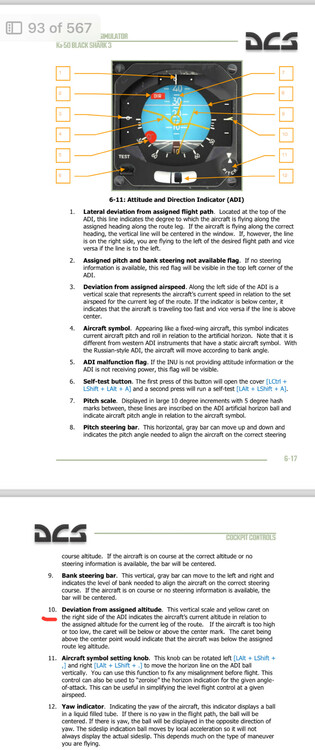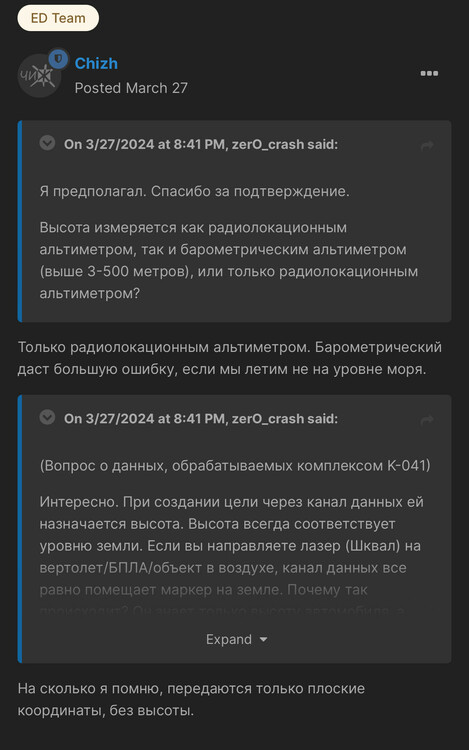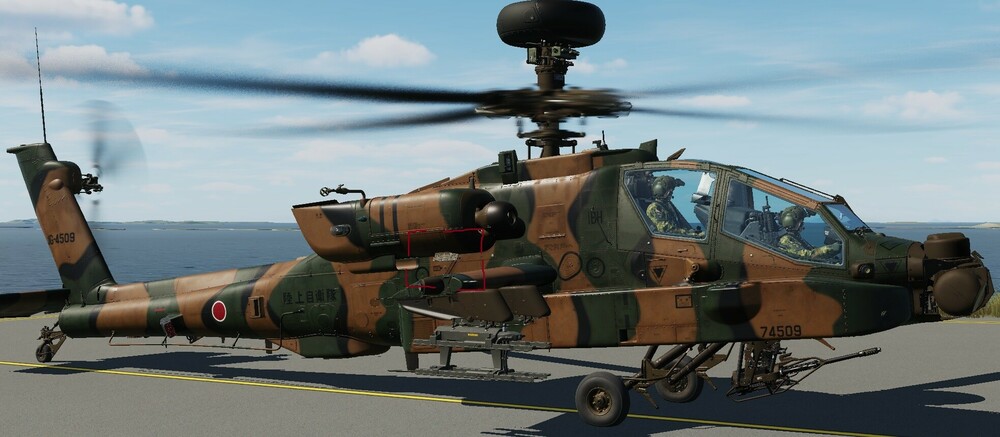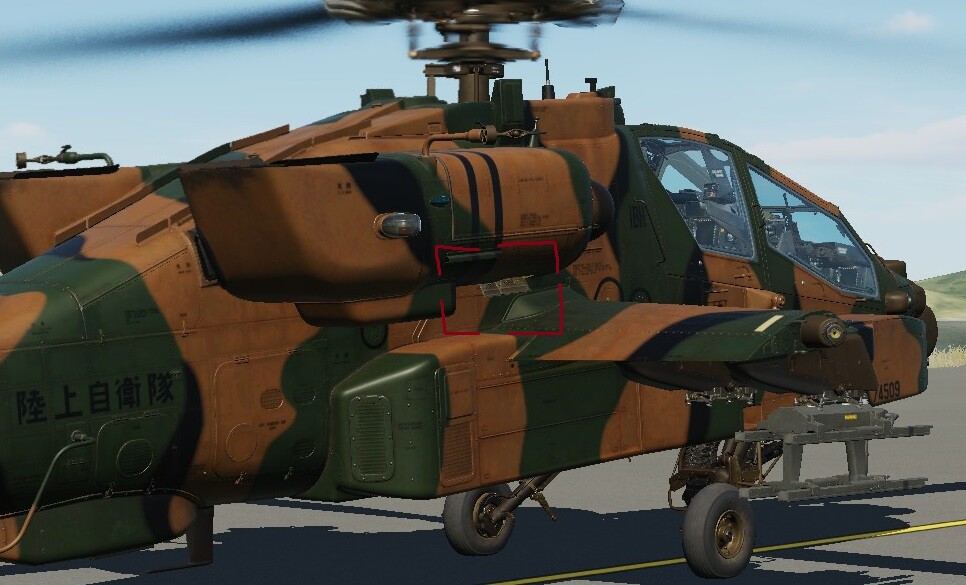-
Posts
1662 -
Joined
-
Last visited
-
Days Won
1
Content Type
Profiles
Forums
Events
Everything posted by zerO_crash
-
Today, this is how it works, but back then (beginnings of GPS), the thinking was different. What I'm stating, is that the solutions that exist today, were not neccessarily discovered back then. That's why, it was never planned, at any stage, to connect the two (you are absolutely wrong in your statement). There is no documentation or source which will confirm that. The later stipulations, came from equipment tests for Ka-52. If you mentioned PVI-800, then it is all about INS. Both real Ka-50 and DCS Ka-50 are the same, as confirmed by ED (access to real Ka-50 manual and other documents). I suggest you re-read what I wrote above - the system is good, but not perfect. For 80s, this was THE thing! Don't bother with the ME setting, as for PVI-800, that is not realistic. That's to say, and I repeat, the PVI-800 is 2D only. How does this matter? Because datalink operates off data from PVI-800. More specifically, PVI-800 creates the basis for the navigational part of PrPNK. When you use Shkval to obtain a target, the coordinates are pulled from your current position (PVI-800), plus IT-23 direction, range (laser) and angles. That data, is then able to be either saved, or sent, and it will show up on the ABRIS. Make no mistake, ABRIS shows the data, but the coordinates are taken from PrPNK (PVI-800) and overlaid on the ABRIS. As such, INS is everything you should worry about here! As to your assumptions, no, they are baseless and false (demagoguery at best). There are no what's and if's. PVI-800 has never had any interface for adding height, because it never accepted more than a 2D input/output (lat/long). The ME is purely a leftover. On RU-side, we are working with settling bugs and false workings. I suggest that you get better acquainted with the manual:
-
I will add, that many of these topics have been raised over rhe years, however with renewed implementations of systems, assurances have to be made with regards to old/new workings.
-
Far off useless, but there is some imprecision built into the system. Remember, that's back in the times when AH-64D didn't exist yet, AH-64A flew with a INS, and that was all the navigation they had. While Ka-50 had GPS, it was idologically, a addition to the otherwise common INS (PVI-800). Back then, it wasn't planned to have the ABRIS and PVI-800 interconnect with each other. Two separate sources, guaranteed redundancy. If you perform precision-alignment of INU properly (no vibration from APU/Engines), plus avoid flying too long in "memory"-mode (eventually correct navigation position before spending time at AO), you will have incredibly good accuracy. Typically, no more than 20-30m off target, for as much as an hour after performing nav. fix. I know because I simply do. You might be able to translate this for yourself: Eventually, have a look at the thread below - nevermind "Pack Rat", he is simply talking about what ifs (we were discussing the trigonometric method used by Ka-50 to obtain ranging without laser rangefinder being used, as well as its efficiency), not the actual system (I have 't had time to correct his last post yet):
-
The PVI-800 does not operate with altitude as a input/output metric. Any point you enter, will get placed on the ground-level. The former implementation was, in fact, wrong.
-
Which altitude are you thinking about? What instrument?
-

work in progress AH-64D Japanese skin glitch
zerO_crash replied to zerO_crash's topic in Bugs and Problems
The glitch specifically occurs with AN/APG-78 installed. Added "TEST"-mission for replication. Simply launch the mission, join the AH-64D-slot, and go to F2-view. TEST.miz You have a US-fleet with Japanese Defense Force skin btw. If authenticity matters, you should change the country of these AH-64s to Japan. -
Discovered by accident that the Japanese skin for the AH-64D has a glitch, where two hatches are open beneath the right engine block.
-
Good stuff
-
Indeed
-
Management is ultimately responsible for core segments of managing, budgeting (expenditure) being one. On paper, I'm sure that they are happier with paying a fraction of IRL training, by the use of simulators. At the same time, I seriously doubt that any company, state or private, would pay for entertainment of their employees (outside of social/efficiency activities). The prospect of defining professional/entertainment, is not possible at a general level. An employee can very easily find interest and enjoyment in their professional occupation. In fact, on the RU-side, we have for example one member, who is working with professional Air Force simulators. To him, it is entertainment, even though a professional burden ($). Let's stick to topic, this is as far away from KW as it gets.
-
More or less. Kola being the most prominent example, let's wait and see if the feedback gets through, and it gets corrected. If a single customer was able to "objectively" bring it closer to IRL relatively easily, I don't see why Orbx would not be able to do the same. That, or a comment from them explaining why they, eventually, believe that this is correct. For the rest, we'd have to open individual topics anyways, I'm afraid. And as said, the more maps come out (and this issue gets delayed) the bigger the work will be with synchronizing all together. This is ultimately a question of policy, much like module quality is, for example. Let's see what time brings. @Stanlesuper You might want to link to this discussion (or add a two pictures (before - after)) in their bug tracker, and post your solution to it.
-
Correct, albeit Germans weren't actually pulling Pugachev's Cobra, but a similar maneuver. The pitch never entered the territory bar minimum of 90* AOA. As to the usefullness of a Cobra maneuver, that is something that imagination and situation dictates. Any real pilot will tell you that a prolonged dogfight (scenario), will result in a ever lower airspeed. That is not a question, it is a fact. That is dictated by whichever opponent pulls the fight slower (in fhe attempt to lower the turn radius). If the contender then, doesn't follow and rather extends, the one doing a tighter, albeit slower turn, will place himself right at the opponents back and have a window for atleast a missile. A cobra, can ultimately cut down the length of the initial engagement, and finish off the target faster. Performing a Cobra, or a derivative, amplifies the AOA for a short while, giving the pilot more opportunities. Being able to pull more AOA, has always been a desired metric in fighter aircraft, whether sustained or instantaneous. If the scenario is, however, comprised of more than 1 vs. 1, then the maneuver will potentially expose you more, by eating all your airspeed. Tactically, it is a stupid choice to use it in this case. There are better tactics involved. The problem is most people don't have rhe capability to think for themselves. They listen to a pilot speak, and parrot whatever they heard. Pilots being good sources, you still have to evaluate the context. Pilot train most often in 1 vs. 1 with guns. IRL, you'd more often than not, have a heatseeker, otherwise avoid engagement. The times of chivalry are long gone, and no pilot is taught to enter a fight in a gentleman-type of way, greeting his opponent. That up until WWI-stuff, and it stayed there. The point being, you might question whether a Cobra-derivative allows for enough aircraft control to use a gun in that window effectively, but IRL, that is enough to pop off a IR-missile or two! Talking about the real aspect of warfare, not a synthetic one, any maneuver closing the loop, is a advantagous one. Whether one uses it or not, is up to the pilot and situation. That's all there is to it! I have never heard a F-18 pilot complain about the Hornets AOA-capabilities (that, understanding that Hornet can pull way more AOA than what its thrust will allow it to hold). Not once, have I heard a pilot criticize it. I haven't either heard a F-22 pilot complain about their 2D thrust vectoring. Sadly, what pilots (just as most humans) are often subject to, is national pride. Until western pilots can perform Pugachev's Cobra, or better, they will muddy the water with their scepticism (based on pride and jealousy). Have you noticed how Eurofighter and basically any other delta-wing configuration has become famous in the modern 4th/5th generation era? A delta configuration, by design, projects high instantaneous turn, at the expense of speed (huge airbrake). That's not enough, to get even more turn, they add canards! If you pull maximum deflection on the control column of the Eurofighter/Rafale, you don't get a Cobra, rather something similar, but the speed will get eaten too. One important point; having capability, doesn't mean that you neccessarily have to use it. It can be a emergency one, depending on what tactics one trains. However, if maneuverability wasn't desired, than all those canards, thrust vectoring nozzles, and much more, is just dead weight. F-22 shouldn't have been chosen, but rather YF-23 with its (supposed) longer range and better speed characteristics - that, where every engagement is a mach 4+ in closure. Nope, I don't think so.
-
Any maneuver, is closely defined with entry-/exit- points, and typically speeds and other mertrics. "Only in one special case..." - Have you ever seen a Pugachev's Cobra performed from anything other than level flight? There is very little "special" about a maneuver, which is always performed in a given way. "Specific", however, is probably what you meant. Still, if initial metrics deviate much, you won't adhere to the full maneuver, which means that you haven't in fact performed a Pugachev's Cobra, but rather, a derivative. People don't understand that maneuvers are not as loosely defined, as a appeoximation of a geometric figure. It's more specific than thay, with relative turn lengths and a total. If you perform a Cuban Eight, albeit horizontally, then you are not performing a Cuban Eight at all.
-
Новые объекты (здания, эстетика, +++), новые дополнения к модулям.
-
I'd have to disagree here. Simulators nowadays, are not what they used to be. They keep getting more and more relevant, as budgets get revised, even for militaries around the world. Have a look at the pilot curriculum in the air force F-35 program - major reliance on simulators. That is, beyond fresh pilot training. Lockheed Martin pride themselves on the similarity between their simulator and the real aircraft, which is why a two-seater F-35 is not needed. The Ka-50/Mi-24, etc... are used in the Russian Air Force, Frontal Aviation and Regional Defense Force. US is the same. Whereas before, it was startup with the A-10C, now, pilots are building muscle memory (tedious practice) and training different scenarios. One could question what is more practical in terms of training; flipping the training-switch in the real airframe and make "buzzing"-sound for non-deployable ordnance in order to immerse oneself, or actually jump into a simulator where a Maverick or JDAM cost equally much. Point being, Ukrianian pilots are training in DCS for F-16/A-10C/Su-27/MiG-29/+. Not only procedures, but even tactics and employment. USAF is likely the biggest user of simulators for their pilots. Ever noticed how, when new airframes are built, they are being put through their paces in a simulator-environment before actually being built and flown? While you cannot simulate G-forces properly in such an environment, you are still replicating a solid portion of the what it is all about. Flight systems, AP, etc... If you'd look at building of missiles/rockets/hypersonics/aircraft/etc.., it's all CFD simulations, with a, comparatively, small amount of IRL testing. Without CFD, F-117 would never fly, yet has had a fairly successful career. What was once thought of as impossible, simulations allow to test, and prove the exact opposite. What you use a simulator for, is of lesser importance. The question that matters, is whether it does the job that it was design for, and whether well enough.
-
Well, size is everything but, simple size. As you mention, small changes in design, can result in astronomical changes to the airframe performance. I'd drop the thrust, in that equation, as whether we talk acceleration or top speed, it's interconnected. Top speed happens at the moment when acceleration equals zero. More important, is simply the basic construct - airframe. That's what really separates these projects from each other. More interestingly, we don't really understand aerodynamics in the mathematical way that we'd want to. The magnitude of effects from different features on an airframe... There is a reason why wind tunnel and CFD is a core part of the testing. Basically, trial and error, with minimum level of confidence in the actual changes. Last I heard, the F-35C (marines, SVTOL) has a limit on how long it can sustain supersonic (x > M 1.0) speed, due to the vertical stabilizers getting cooked (not tollerating temperature), as well as cracks, deformations and exponentially accelerated wear occuring. You'd expect that with an airframe this expensive, and some 20 years delayed, such basic issues would have been solved. Granted, the topic of aerodynamics itself, is incredibly versed and diversified in the range of speeds/altitudes/pressures/temperatures/etc... That's not even considering building an aircraft.
-
No, not mad. Rather, with regards to the comment, expcting some background. Don't take this personally, it's called source verification. Not everything needs it, but this topic certainly did. It is a poor form of communication to distribute different information on different channels. Polychop (not only) has certainly potential for improvement in this department (not everyone participates on Discord, or in dev. channels). How through the "inspection" of UH-1H was as a product, we don't know, other than Bell associates actually having tried it. Kamov JSC also performed tests (to some degree) on the Ka-50, before BS1 got approved. It seems to be the norm that a 3rd party can easily establish confidence in their product based on a more thorough and objective process. Why, according to the linked Discord comment, that is a "private" matter, is suprising from the perspective of PR. Still, it's their choice to make. Enjoy that F-4E, looks pretty neat! It very much depends on the company and what standards they hold themselves up to. I imagine, that within a simulated environment, a company that gives their approval and marketing permission, the quality of the product as a whole, matters more. No one would hold Bell responsible for a "gamey"-product like Ace Combat. In a simulated (i.e. more serious) environment, however, if things are off, one does tend to ask questions. Liability at its lowest form (customer). Another thing is, as you point out, that the companies themselves are often interested in using/adjusting the product to their own needs. In that capacity, I doubt we'll ever get Dolce Gabbana stamp their watermark, guaranteeing for the smell of the exhaust fumes of F-35. The companies who are interested in DCS/simulated environment, are often the ones who benefit from the product itself. At least now, we know, that we won't know about Bell and KW. Should there be inaccuracy, Bell won't risk having determined sim-pilots knock on their door, demanding explanation.
-
Очень интересно и познавательно. Полностью с тобой согласен, братишка. Признаю свою ошибку. Спасибо, что поднял эту тему
-
Интересно. Ну, нет статьи в Википедии - я не доверяю. Везде в сети видел название "Кокон": https://topwar.ru/32206-shturm-s-protivotankovyy-schit-suhoputnyh-chastey.html http://militaryrussia.ru/blog/data:image/index-175.html http://epizodsspace.airbase.ru/bibl/tehnika_-_molodyoji/2007/6/18-19.html Я удивлён, что это неправильно - кажется, интернет цитирует сам себя и повторяет ошибку. Из прочтения понял, что у комплекса одно название, а у ракеты другое. Откуда взялось название "Кокон"? Похожий проект или творческий разум?
-
I see!
-
No one made the assumption about colorblind, but as you should know, with current workload, if something isn't deemed requested or popular, it gets a backseat in waiting for a fix. I leave that to ED and their staff. What I do, however, help with, are simpler solutions which can spare much hard work. Simpler, as in better, not quantity substituting quality, mind you. Well, ultimately we are talking about bringing everything to more realistic. Caucasus is good for what it is, but objectively, can appear vivid in its color palette at times. A more pronounced example would be the Normandy map. It does have extremely lively greens, almost too perfect. Still, this pales in comparison to Kola. I'm mentioning that there is more work to be done, in the grand scheme of things, with Kola only being an example. We'll see what comes out of it down the line.
-
I infer that from the Bell trademark. As serious company as they are, it would be surprising if they allowed to make PR and money off their image, without having checked what they vouch for to begin with. That, even while getting commission from underlying sales. It is essentially what Bell did with the UH-1H in DCS. It'd be interesting to have that confirmed. The question was obviously directed at devs. Since you chose to answer, you might as well produce a source.
-
It's connected to the "helmet" volume under the sound settings. Any kind of warning in a module, typically is (not always though).
-
I'll use the example of the AH-64D. When flying at night, the cockpit lighting of the CPG, can often prove a discomfort/inefficiency. Instead of creating more "specific" commands, why not have the AI (regardless of seat), copy the cockpit light setting which the human pilot uses? All elements of tge cockpit would be tied together in a logical way, such that if the human pilot turned down the brightness of the radios, the AI would (20 sec. delay) adjust theirs to the same level. The main question is what if the elements within the cockpits are different. Well, in AH-64D the pilot has two MFDs while the CPG has three. Solution, tie the middle MFD to either the right or the left one (two MFDs adjusted by AI for one pilot MFD). What if e.g. the pilot doesn't have at all a function that the CPG has? Simple, connect that CPG lighting function to something general - flood lights, instrumentation lights, etc... I'm thinking generally for all multi-seat (in cockpit) modules, this should be a common solution. It is really needed.
-
- 1
-

-
Interesting, that "Bell" logo would indicate to me that Bell test-flew it and approved the authenticity of the module. @Polychop Simulations Am I right in my assumption?






